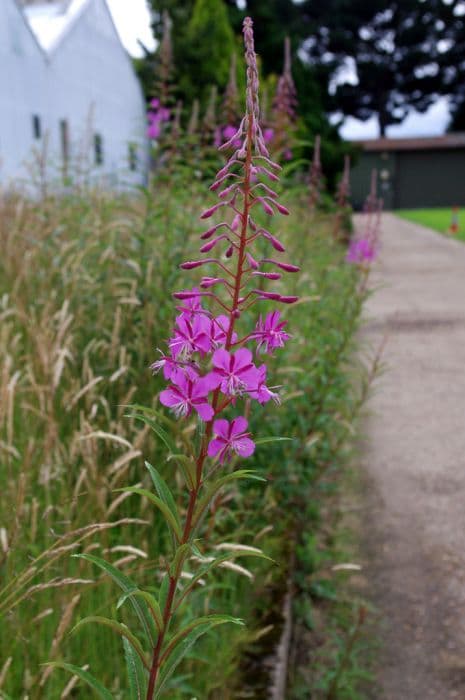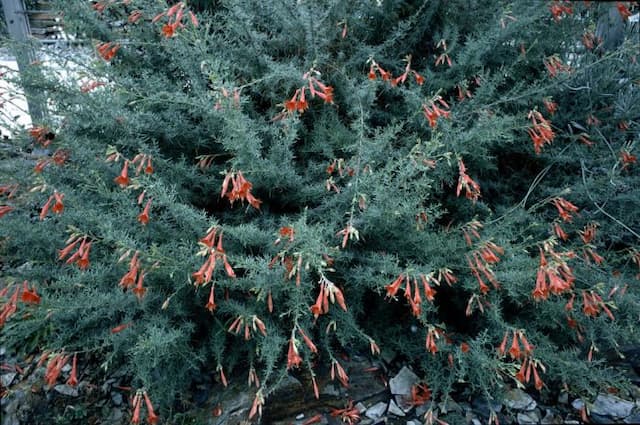Fuchsia Fuchsia 'Orange Crush'

ABOUT
The Fuchsia 'Orange Crush' is a striking plant known for its unique and vibrant blooms. Its flowers are the most distinctive feature, characterized by a stunning gradient of orange shades, resembling the playful nature of a tropical sunset. These flowers hang from the branches in a teardrop shape, with a bell-like structure surrounded by long, slender petals that often curl elegantly at the tips. The outer skirt of the petals showcases a lighter orange, almost peachy hue, while the inner corolla blooms with a deeper, fiery orange tone. The foliage of the Fuchsia 'Orange Crush' is a lush, deep green, creating a dramatic backdrop for the spectacular flowers. The leaves are oval with a slight point at the tip and have a subtle serration along the edges which can provide a textural element to its overall appearance. Depending on the maturity of the plant, the arrangement of the leaves can create a bushy silhouette that adds to its ornamental appeal. This variety of fuchsia tends to have a graceful growth habit with branches that may arch under the weight of the blooms, giving it an elegant, cascading effect when well maintained. The stems are also green, sometimes with a slight purplish tinge, which complements the vivid coloring of the flowers and foliage alike. The overall impression of the Fuchsia 'Orange Crush' is one of vividness and exotic charm, making it a delightful addition to any garden space or as a potted spectacle for a balcony or patio.
About this plant
 Names
NamesFamily
Onagraceae
Synonyms
Fuchsia 'Orange Crush'
Common names
Fuchsia 'Orange Crush'.
 Toxicity
ToxicityTo humans
Fuchsias, including the 'Orange Crush' variety, are generally regarded as non-toxic to humans. Therefore, they aren’t likely to cause poisoning if ingested.
To pets
Fuchsias, such as the 'Orange Crush' variety, are typically considered safe for pets. They are not known to be toxic to cats, dogs, or other domestic animals, and ingestion will not usually result in poisoning.
 Characteristics
CharacteristicsLife cycle
Perennials
Foliage type
Deciduous
Color of leaves
Green
Flower color
Orange
Height
2 feet (0.61 meters)
Spread
3 feet (0.91 meters)
Plant type
Shrub
Hardiness zones
9
Native area
Central America
Benefits
 General Benefits
General Benefits- Attracts Pollinators: Fuchsia 'Orange Crush' is known to attract hummingbirds and beneficial insects, which can help pollinate the garden.
- Colorful Blooms: It provides vibrant orange-red flowers that can brighten up any garden space.
- Long Blooming Period: This plant has a long flowering season, often from early summer until the first frosts, providing prolonged visual interest.
- Suitable for Containers: Its growth habit makes it ideal for hanging baskets and containers where its trailing stems and flowers can be displayed to dramatic effect.
- Shade Tolerant: Fuchsia 'Orange Crush' can thrive in partial shade, making it a great option for garden areas that don't receive full sunlight.
- Easy to Propagate: It can be easily propagated from cuttings, allowing gardeners to create more plants for use elsewhere or to share with friends.
- Versatile Use: Can be used in varied landscaping designs, including borders, containers, and as an accent plant.
 Medical Properties
Medical PropertiesThis plant is not used for medical purposes.
 Air-purifying Qualities
Air-purifying QualitiesThis plant is not specifically known for air purifying qualities.
 Other Uses
Other Uses- As a natural dye: The vibrant flowers of Fuchsia 'Orange Crush' can be used to produce a natural dye for fabrics, lending a unique hue to textiles.
- In photography: The striking colors of Fuchsia 'Orange Crush' can provide an excellent contrast in floral photography, making it a popular choice for photographers.
- As a teaching tool: Botany educators might use Fuchsia 'Orange Crush' to teach principles of hybridization, pollination, and ornamental horticulture.
- In arts and crafts: The flowers can be used in dried flower arrangements or pressed flower art, given their distinctive shape and color.
- As a color inspiration: Artists may take inspiration from the fuchsia's color palette to develop paint or color schemes for their artwork.
- For culinary decoration: Although not commonly eaten, the petals of Fuchsia 'Orange Crush' can be used as an edible decoration on cakes and desserts.
- As a potpourri ingredient: Dried fuchsia flowers can add color and a light scent to homemade potpourri mixes.
- In fashion: The fuchsia flower can inspire designs or patterns in the textile and fashion industry due to its unique and striking appearance.
- For thematic gardening: Gardeners might use Fuchsia 'Orange Crush' in a 'tropical' or 'fiesta' themed garden for its bright, lively appearance.
- As a mood enhancer: The vivid and cheerful flowers of the Fuchsia 'Orange Crush' might be utilized in floral arrangements intended to elevate mood and create a sense of happiness in interior spaces.
Interesting Facts
 Feng Shui
Feng ShuiThe Fuchsia is not used in Feng Shui practice.
 Zodiac Sign Compitability
Zodiac Sign CompitabilityThe Fuchsia is not used in astrology practice.
 Plant Symbolism
Plant Symbolism- Confiding Love: Fuchsia flowers, in general, can symbolize confiding love, making them a gift to express trust and intimacy.
- Good Taste: The elegant appearance of the Fuchsia plant is often associated with good taste and sophistication.
- Vibrancy and Energy: The 'Orange Crush' variety, with its bright orange color, symbolizes vibrancy and an energetic spirit.
- Grace Under Pressure: Fuchsia plants can thrive in challenging conditions, representing grace under pressure or maintaining composure in difficult times.
 Water
WaterFuchsia, commonly known as Lady's Ear Drops, requires consistent moisture and should not be allowed to dry out. Water thoroughly when the top inch of soil feels dry to the touch, which typically means watering at least once or twice a week. During hot spells, Lady's Ear Drops may need water more frequently, possibly every other day, ensuring you provide enough water so it reaches the entire root zone. On average, this can equate to about 1/2 to 1 gallon of water per week, depending on the size of the plant and environmental conditions. It's essential to provide a balance and avoid overwatering, which can lead to root rot.
 Light
LightLady's Ear Drops thrive in bright but indirect light. The best spot for these plants is where they receive morning sunlight but are protected from the intense heat of the afternoon sun. An eastern-facing porch or patio where they can get good morning light or a place with filtered light, like under a tree with dappled sunlight, is ideal for their growth.
 Temperature
TemperatureLady's Ear Drops prefer cooler temperature conditions and perform best when daytime temperatures are between 60 to 70 degrees Fahrenheit. They can survive minimum temperatures down to about 50 degrees Fahrenheit and should not be exposed to temperatures over 80 degrees Fahrenheit for prolonged periods, as extreme heat can cause stress and wilt. Ideal night temperatures are cooler, around 55 to 65 degrees Fahrenheit.
 Pruning
PruningPruning Lady's Ear Drops is important to promote bushier growth and abundant flowering. Pinch or trim back the tips of stems and remove any dead or damaged flowers and leaves to encourage new growth. This should be done throughout the flowering season. The best time for extensive pruning is late winter to early spring before new growth starts.
 Cleaning
CleaningAs needed
 Soil
SoilFuchsia 'Orange Crush', commonly known as Fuchsia, thrives in well-draining, fertile soil with a pH of 6.0 to 7.0. The best soil mix for this plant is one part peat moss, one part loam, and one part perlite or sand to ensure proper drainage and aeration. Avoid heavy garden soils that can lead to waterlogging, potentially harming the plant.
 Repotting
RepottingFuchsias like 'Orange Crush' should be repotted every two to three years, preferably in the spring. This allows for fresh soil replenishment and root pruning if necessary. If the plant shows signs of being root-bound or if the soil quality deteriorates, it may need more frequent repotting.
 Humidity & Misting
Humidity & MistingFuchsia 'Orange Crush' prefers high humidity levels, ideally between 60-70%. To maintain optimal humidity, regularly mist the plant or use a humidity tray. Avoid placing it in dry, arid environments as this can stress the plant.
 Suitable locations
Suitable locationsIndoor
Place Fuchsia 'Orange Crush' in bright, indirect light and maintain high humidity.
Outdoor
Hang Fuchsia 'Orange Crush' in partial shade and shelter from strong winds.
Hardiness zone
10-11 USDA
 Life cycle
Life cycleThe life cycle of the Fuchsia 'Orange Crush', commonly known as Fuchsia, begins with seed germination, usually in the spring when temperatures are warm enough for the seeds to sprout. After germination, the seedling stage follows, during which the plant develops its first true sets of leaves and begins to grow rapidly. The vegetative stage is marked by the Fuchsia establishing a strong root system and abundant foliage in preparation for flowering. Flowering occurs during the warmer months, displaying the plant's distinctive hanging blooms that are orange-red in color, which, if pollinated, can lead to the production of fruit. The fruit matures and releases seeds, completing the reproductive cycle. Finally, as a perennial, the Fuchsia 'Orange Crush' may enter a period of dormancy during colder months, reducing growth until the following spring when the cycle can begin anew.
 Propogation
PropogationPropogation time
Spring-Early Summer
Fuchsia 'Orange Crush', commonly known as Fuchsia, can be propagated through semi-hardwood cuttings taken during late summer or early autumn. This involves selecting a healthy, non-flowering shoot and cutting a length of about 4 to 6 inches (10 to 15 centimeters) with a sharp, clean pair of scissors or secateurs. The lower leaves are then removed, and the cut end dipped in rooting hormone powder to encourage root development. The cutting should be placed in a pot filled with a moistened mixture of peat and perlite or a well-draining potting mix, ensuring that several nodes where the leaves were removed are buried in the substrate. The pot should be placed in a warm, bright location out of direct sunlight and kept moist until roots develop and new growth is evident, which may take several weeks. Once rooted, the new Fuchsia plant can be potted up into a larger container and grown on as normal.









